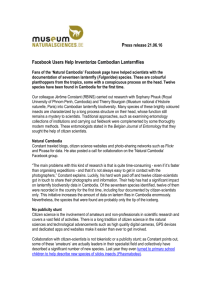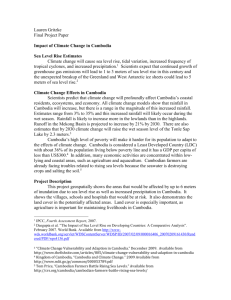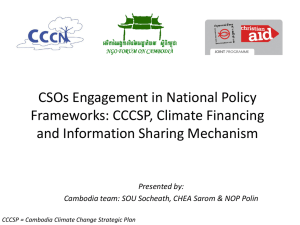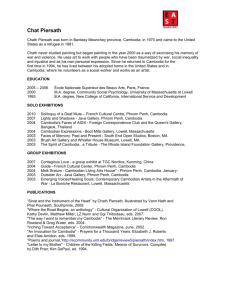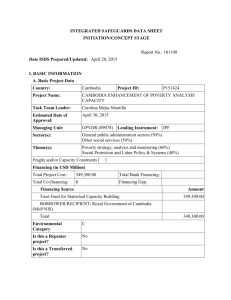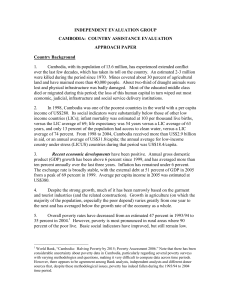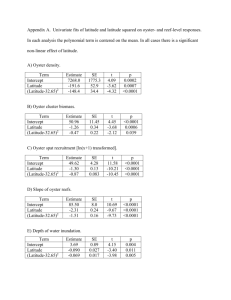Assignment 10 -Detailed Project Plan
advertisement
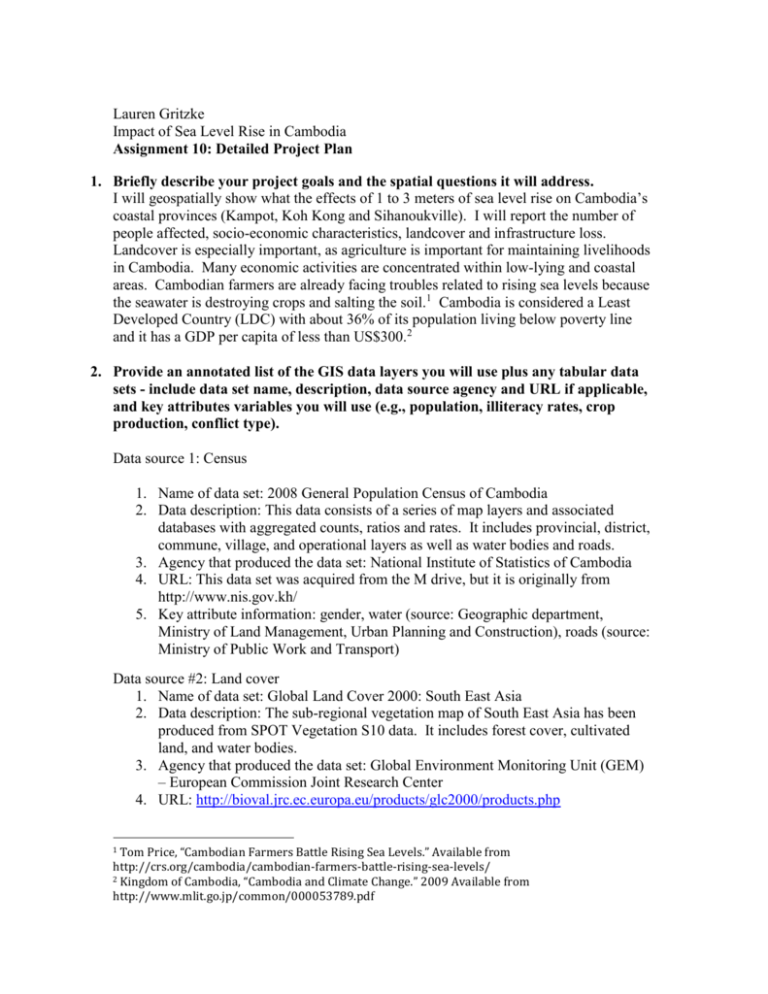
Lauren Gritzke Impact of Sea Level Rise in Cambodia Assignment 10: Detailed Project Plan 1. Briefly describe your project goals and the spatial questions it will address. I will geospatially show what the effects of 1 to 3 meters of sea level rise on Cambodia’s coastal provinces (Kampot, Koh Kong and Sihanoukville). I will report the number of people affected, socio-economic characteristics, landcover and infrastructure loss. Landcover is especially important, as agriculture is important for maintaining livelihoods in Cambodia. Many economic activities are concentrated within low-lying and coastal areas. Cambodian farmers are already facing troubles related to rising sea levels because the seawater is destroying crops and salting the soil.1 Cambodia is considered a Least Developed Country (LDC) with about 36% of its population living below poverty line and it has a GDP per capita of less than US$300.2 2. Provide an annotated list of the GIS data layers you will use plus any tabular data sets - include data set name, description, data source agency and URL if applicable, and key attributes variables you will use (e.g., population, illiteracy rates, crop production, conflict type). Data source 1: Census 1. Name of data set: 2008 General Population Census of Cambodia 2. Data description: This data consists of a series of map layers and associated databases with aggregated counts, ratios and rates. It includes provincial, district, commune, village, and operational layers as well as water bodies and roads. 3. Agency that produced the data set: National Institute of Statistics of Cambodia 4. URL: This data set was acquired from the M drive, but it is originally from http://www.nis.gov.kh/ 5. Key attribute information: gender, water (source: Geographic department, Ministry of Land Management, Urban Planning and Construction), roads (source: Ministry of Public Work and Transport) Data source #2: Land cover 1. Name of data set: Global Land Cover 2000: South East Asia 2. Data description: The sub-regional vegetation map of South East Asia has been produced from SPOT Vegetation S10 data. It includes forest cover, cultivated land, and water bodies. 3. Agency that produced the data set: Global Environment Monitoring Unit (GEM) – European Commission Joint Research Center 4. URL: http://bioval.jrc.ec.europa.eu/products/glc2000/products.php Tom Price, “Cambodian Farmers Battle Rising Sea Levels.” Available from http://crs.org/cambodia/cambodian-farmers-battle-rising-sea-levels/ 2 Kingdom of Cambodia, “Cambodia and Climate Change.” 2009 Available from http://www.mlit.go.jp/common/000053789.pdf 1 5. Key attribute information: cultivated and managed lands (irrigated and nonirrigated) and tree cover (irrigated and non-irrigated). Data source 3: Elevation 1. Name of data set: ASTER Global DEM data 2. Data description: Its purpose was to provide comprehensive elevation data of the world. ASTER GDEM covers land surfaces between 83°N and 83°S and is comprised of 22,702 tiles. It covers 99% of the earth’s surface. 3. Agency that produced the data set: NASA/METI (Japan’s Ministry of Economy, Trade and Industry) 4. URL: http://gdex.cr.usgs.gov/gdex/ 5. Key attribute information: elevation. Data source 4: Poverty 1. Name of data set: Small Area Estimates of Poverty and Inequality (SAEPI) database. 2. Data description: Contains poverty, inequality, and related data at the commune level in Cambodia. These measures are derived on a country-level basis from a combination of census and survey data using small area estimates techniques. 3. Agency that produced the data set: Center for International Earth Science Information Network (CIESIN), Columbia University -Original data source: The Ministry of Planning, Royal Government of Cambodia and the U.N. World Food Programme. (2002). Estimation of Poverty Rates at Commune-Level in Cambodia: Using the Small-Area Estimation Technique to Obtain Reliable Estimates, pp. 65. 4. URL: http://sedac.ciesin.columbia.edu/povmap 5. Key attribute information: poverty rates at the commune level 3. The data creation and/or data processing/analysis steps that you expect perform you can provide this as a numbered set of steps or in a flow diagram. Be as specific as possible, relating the project step to the data layer(s) - this will be the road map for your project. I will use UTM Zone 48 for my projected coordinate system. I will conduct analysis for 1 to 3 meters sea level rise. I will download ASTER elevation data for Cambodia’s coastal land area (in UTM zone 48) in GeoTiff format. If necessary, I will use the tool “Mosaic to New Raster” to merge raster data sets. I will use the Reclass tool to reclassify the Aster data to set everything up to 3 meters to be 1, and everything else to be NoData. Thus, nothing above that elevation will be part of the analysis. I will use the Spatial Analyst tool – Zonal – Tabulate Area tool to calculate the total area of each landcover in the inundation zone (reclassed to be 1). This reports the area of each landcover in the zone in meters. I will convert this to square kilometers and percentages in Excel and have this as a table in my poster. Since most of the other data is vector data, I will convert the inundation zone to vector polygons. This can be done using the Conversion from Raster toolbox, using the Raster to Polygon tool. I will use the Select tools to select out the census districts within your inundation zone and use that selected set to report out in a table the population and other socio-economic data for the zone (and visualizing it on the map). I can count the number of schools, hospitals and other infrastructure inside the inundation zone by selecting them. 4. The products you will produce (list of maps and tables) 1. Map of inundation zone – 1 to 3 meters sea level rise (may separate into 3 different maps) 2. Table: total area of each landcover in the inundation zone 3. Map of poverty levels in Cambodia 4. Map of schools, hospitals, roads etc within the inundation zones 5. Table: number of schools, hospitals, roads etc affected by sea level rise (at each level)
